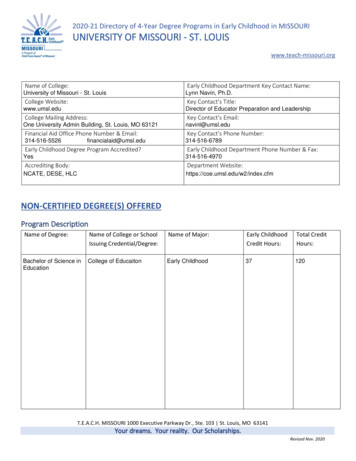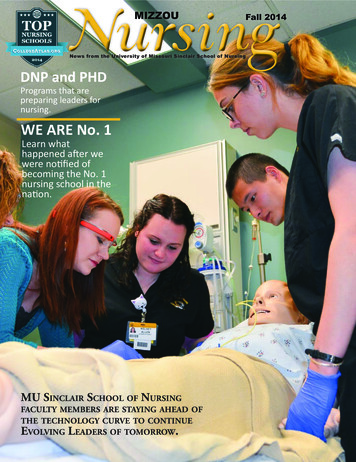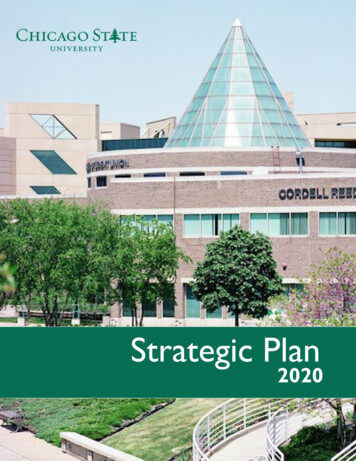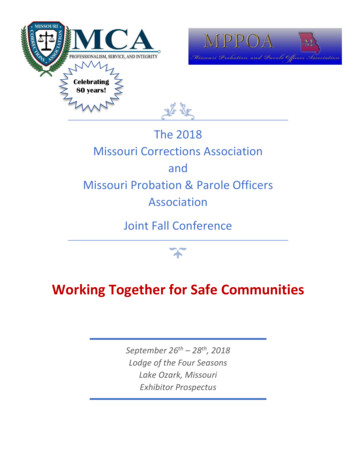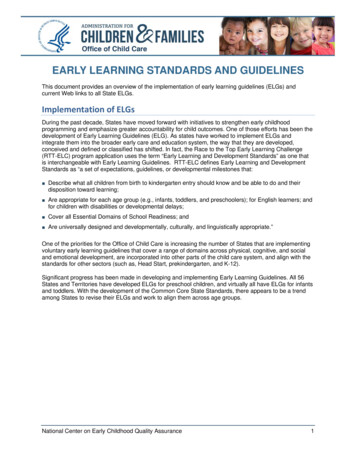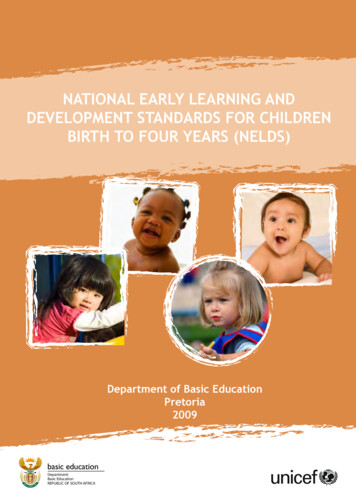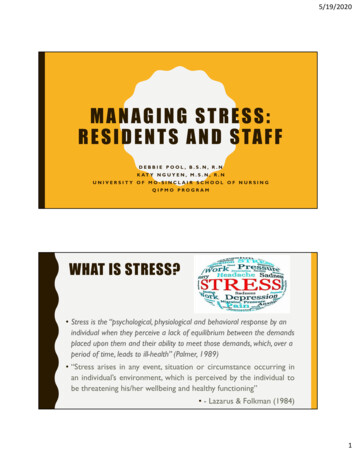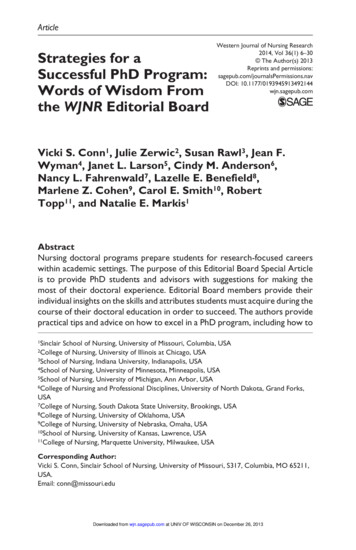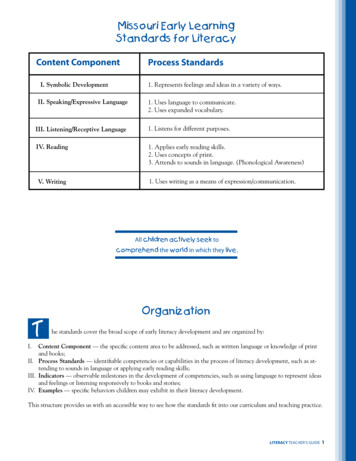
Transcription
Missouri Early LearningStandards for LiteracyContent ComponentProcess Standards1. Represents feelings and ideas in a variety of ways.I. Symbolic DevelopmentII. Speaking/Expressive Language1. Uses language to communicate.2. Uses expanded vocabulary.III. Listening/Receptive Language1. Listens for different purposes.IV. Reading1. Applies early reading skills.2. Uses concepts of print.3. Attends to sounds in language. (Phonological Awareness)V. Writing1. Uses writing as a means of expression/communication.All children actively seek tocomprehend the world in which they live.I.TOrganizationhe standards cover the broad scope of early literacy development and are organized by:Content Component — the specific content area to be addressed, such as written language or knowledge of printand books;II. Process Standards — identifiable competencies or capabilities in the process of literacy development, such as attending to sounds in language or applying early reading skills;III. Indicators — observable milestones in the development of competencies, such as using language to represent ideasand feelings or listening responsively to books and stories;IV. Examples — specific behaviors children may exhibit in their literacy development.This structure provides us with an accessible way to see how the standards fit into our curriculum and teaching practice.literacy TEACHER’S Guide1
2TEACHER’s Guide LITERACY
Introduction for TeachersThis guide, along with the Parents’ Guide, is a companion piece to the Missouri Early Learning Standardsfor Literacy. It is intended for all adults who work with preschool age children and their families- teachers,caregivers, and/or parent educators. The guide is designed to provide an explanation of the standards andcontains practical suggestions for creating engaging, developmentally appropriate learning communities where eachchild’s literacy development is fostered.Why is it important to have standards for early literacy? In Missouri, the Outstanding Schools Act of 1993 calledtogether a group of master teachers, parents, and policy makers from around the state. The Show-Me Standards were theresult of that group’s work. Those standards are designed for students in kindergarten through grade 12 and serve to ensurethat graduates of Missouri’s public schools have the knowledge, skills, and competencies to lead productive, fulfilling, andsuccessful lives. However, we all realize that the foundations for learning are laid well before a child enters kindergarten!In fact, research tells us that the pre-kindergarten years provide crucial opportunities for educators and caregivers toinfluence children’s growth and development. If our goal is that every child enter kindergarten ready to learn and succeed,pre-kindergarten educational standards can provide us with shared understandings about the competencies critical for thisto occur. In addition, early learning standards provide a direct link to the Show-Me Standards, so we know that we arepreparing children for the high expectations they will encounter as they progress through school.To this end, the Missouri Early Learning Standards for Literacy describe what most children should know and be ableto do in the area of literacy by the time they enter kindergarten. They represent a shared set of expectations for preschoolchildren, expectations developed by drawing upon current research about how young children learn. It is important tokeep in mind, however, that children learn and develop in their own unique ways. While research demonstrates that thesestandards are appropriate for most children who are about to enter kindergarten, our responsibility as educators is to assesswhere each child is on the literacy continuum and build on what that child knows and can do.Ongoing, observational assessment is thus a key element in supporting children’s early literacy development. Thisguide will illustrate some indicators that teachers can reliably assess to show each child’s progress over time. This data canbe used to plan meaningful, engaging learning experiences that both promote literacy development and a love for readingand writing. In addition, you will find information about creating literacy-rich environments and partnering with parentsand families to promote literacy and an enthusiasm for learning. A list of helpful resources is included as well.literacy TEACHER’S Guide3
4TEACHER’s Guide LITERACY
I. Symbolic DevelopmentThis standard refers to the child’s ability to interpret, create and use symbols to represent something (an idea, a feeling,or an object) that is not present. The capacity for symbolic development is integral to literacy, although some adultsmistakenly assume that symbolic activities are less critical to a child’s development than language activities. It isthrough symbolic expression that the young child’s imagination and abilities to communicate ideas and feelings flourish.It provides the child with the means for representing what they know about their world, as well as for thinking aboutimaginary and real-life situations.1. Represents feelings and ideas in a variety of ways.IndicatorsExamplesThe child .pretends to be a firefighter, doctor, mother, father, etc.cooperates during play with others (e.g., children work together to build a castle with blocks).creates play themes with others (e.g., “I’ll be the mommy, you are the baby, and we’ll go shopping).attaches emotion to pretend play.a. Represents feelings and ideasthrough pretend play. b. Represents feelings and ideasthrough movement. pretends to move, run, jump, crawl, hop, skate, etc., like an elephant, airplane, dancer, bird, etc. expresses his/her feelings through movement (e.g., jumps with excitement, stomping feet inc. Represents feelings and ideasthrough music. responds to different kinds of music (e.g., marches to music, relaxes to soft music). joins in singing favorite songs, saying rhymes, finger plays, etc. creates music and songs (e.g., changes words to familiar tune, plays pretend instruments).d. Represents feelings and ideasthrough art and construction. draws or paints pictures and tells others about his/her pictures. builds with blocks, Lego’s, tinker toys, etc., and says, “I made a castle.” responds to others when asked to tell about a construction or a drawing.frustration).interpret, create and use symbols torepresent something that is not presentliteracy TEACHER’S Guide5
Teacher strategies to promote children’s symbolic development include: allowing enough time and space for make believe play.providing prop boxes and/or props in general for pretend play.developing theme units with supporting materials.acting out familiar stories as a group and/or providing props so that children can “retell” favorite stories on their own.providing a well-equipped play area.providing puppets, realistic animal and people figures in the block area.having a supply of recyclables accessible to children so they can create their own props.allowing enough time and space for movement activities.incorporating movement activities into the daily schedule.presenting invitations, or posing open-ended problems, instead of giving directions to act or move in a certain way.incorporating music/singing together into the daily schedule.providing a variety of instruments for children to play.providing materials for children to create their own instruments.playing rhythmic pattern games (e.g., clapping games).equipping listening center with a variety of tapes and headphones.using music and/or songs to signal transitions.allowing enough time and space for children to build/construct with materials, as well as for art exploration.allowing children to explore and create with art materials, rather than engage in craft projects designed to produceidentical products. providing a variety of paper, poster board, art supplies, paints, markers, as well as a supply of clay, etc., organized sothey are freely accessible to children. providing a variety of blocks, rollers, Lego’s, etc., organized so that they are freely accessible to children.6TEACHER’s Guide LITERACY
II. Speaking/Expressive LanguageThese standards refer to the child’s ability to express him/herself using language. Children learn how language works byactively and purposefully interacting with other people and the environment. They operate under the assumption thatlanguage is orderly and they try out various alternatives in an attempt to discover that order. In the process of teaching themselves how spoken language works, children construct their own rules, based on their understanding of adultspeech. For example, a child might say “foots” instead of “feet” as they experiment with spoken language. As they havemore opportunities to express themselves, they increase their understanding of how language works by building on whatthey already know and revising their theories of how language operates.1. Uses language to communicate.IndicatorsExamplesThe child .a. Communicates in home languageand is understood by others. uses English, Spanish, sign, or other native language for a variety of purposes. communicates personal needs, preferences, and feelings.b. Initiates and respondsappropriately in conversationand discussions with adults andchildren. responds to how others feel and expresses concern. shares information and gives directions, especially during play. engages in turn-taking conversations. asks why, what, when, where questions.2. Uses expanded vocabulary.IndicatorsExamplesThe child .a. Uses language to pretend orcreate. pretends with words or actions to be a story/television character.b. Uses complete sentences ofvarying length. uses descriptive language (e.g., color words, sizes, shapes). acquires new vocabulary. makes up rhymes of songs. tells real or make believe stories. tells and laughs at exaggerated stories. asks and answers questions for information. uses new vocabulary during play.Teacher strategies to promote children’s speaking/expressive language include: providing time for student-initiated talk on matters important to them. encouraging peer interactions throughout the day. introducing topics at circle time that encourage children’s verbal participation. holding class meetings to resolve conflicts, make grocery lists, vote, etc. modeling how to ask and answer questions. singing “open-ended” songs that children can supply words for. reading and discussing stories with a small (2-3) group of children. providing opportunities/materials to introduce new words in a way that’s meaningful for children(e.g., “Yes, that is a bug and it’s called a spider.”).literacy TEACHER’S Guide7
III. Listening/Receptive LanguageThis standard refers to the child’s ability to give attention to and understand language. Speaking and listening areinteractive processes and as children build their capacity to listen attentively, they increase their understanding of howpeople communicate with each other.1. Listens for different purposes.IndicatorsExamplesThe child .a. Follows simple directions. follows 2-step directions, “Put away your crayons and go to the door.” follows 3-step directions, “Pick up your toys, brush your teeth, and put on your green shirt.”b. Listens responsively to booksand stories. responds to books and stories with facial and body gestures (smiling, laughing, etc.). responds verbally to the story or text.c. Listens to and engages inconversations with others. responds appropriately to the words of another in an exchange of ideas, comments, or questions.d. Responds to questions. answers simple questions (e.g., “What would you do if you fell off your bike and hurt your knee?”).Teacher strategies to promote children’s listening/receptive language include: reading aloud oftenproviding opportunities for children to interact with peers throughout the dayproviding opportunities for asking and answering questionsengaging children in one-on-one conversationsspeaking and listening are interactive processes8TEACHER’s Guide LITERACY
IV. ReadingThis standard refers to the child’s increasing ability to recognize and understand print and books. Children notice thatreaders respond to signs and directions, consult recipes, pour over newspapers, or relax with novels. They have a greatinterest in being read to and in printed text. For example, children will ask, “what is that word?’ or “what does that say?”They often memorize favorite stories and spend time “reading” to themselves, or picking out words that they know.They are constructing the understanding that print/books conveys meaning.As children begin to learn how language works, they start to make the connection that there are specific soundsassociated with the language they speak and the environment they live in. They explore sound patterns and rhymes,and begin to notice that inflections (changes in a speaker’s pitch or loudness) can hold meaning. In the course of theirexplorations, they discover the letter/sound connection as well — a crucial building block for literacy.1. Applies early reading skills.IndicatorsExamplesThe child .a. Shows interest in reading andbooks. recognizes and frequently requests favorite book(s). chooses to “read” or look at books. responds to and talks about the pictures in books.b. Exhibits book-handling skills. holds a book upright and turns pages in the book, front to back. begins to scan pages from top to bottom and left to right. knows a book is for “reading.”c. Pretends to read easy orpredictable books or tries toread along during his/herfavorite part of story. joins in with predictable phrases (e.g., “Run, run, as fast as you can. You can’t catch me, I’m theGingerbread Man”). uses pictures and/or context to construct meaning. may “read” beginning books, wordless books, familiar rhyming books, and/or predictable books byrecreating the story from memory and/or picture cues.d. Comprehends and respondsto text. e. Develops a sense of story. tells a story from pictures. recognizes variations in retelling of stories. predicts outcomes of stories. tells stories with beginnings, middles, and ends. dictates stories for others to write down. tells stories based on personal experiences, imagination, dreams, and/or stories from books. recalls information about settings, characters, events in a story.identifies known objects in illustrations.talks about or expresses emotion in reaction to text.makes predictions and may use the pictures as a guide (e.g., “I bet he is going to fall.”).uses the voice of a character (e.g., “Reads” text like “I’m the Mean Old Troll.”).literacy TEACHER’S Guide9
IV. Reading2. Uses concepts of print.IndicatorsExamplesThe child .a. Reads environmental print andsymbols. recognizes fast food and store signs (e.g., McDonald’s, K-Mart). recognizes product logos (e.g., Cheerios, Barbie, Lego’s). recognizes environmental signs (e.g., STOP, MEN, WOMEN, EXIT).b. Identifies some alphabet letters. identifies some letters in his/her name. may identify letters in other personally significant words (e.g., “c” for cookie, “d” for dog, “m”for mom).c. Recognizes that print representsspoken words. recognizes first name in print.knows that the label “chair” on a chair means chair.looks at words on the page of a book and “reads” the story.recognizes that a letter is different from a word.Reads environmental10TEACHER’s Guide LITERACYprint and symbols.
IV. Reading3. Attends to sounds in language.(Phonological Awareness)IndicatorsExamplesThe child .a. Repeats rhymes, simple songs,poems and finger plays. says or sings nursery rhymes such as Humpty Dumpty. sings simple songs such as Twinkle Twinkle Little Star. says poems and finger plays such as Itsy Bitsy Spider.b. Participates in word games. claps along with syllables of words (e.g., claps names and rhythms). creates words by substituting one sound for another (e.g., “I like to eat Apples and Bananas,Opples and Bononos” “Willoby, Wallaby, Woo”). participates in rhyming games (e.g., going on a bear hunt and find something that rhymes withsock).c. Discriminates some sounds inwords. attends to books that focus on specific sounds (e.g., JAMBERRY, FOX IN SOCKS, WHO’S IN THESHED). perceives differences between similar sounding words (e.g., coat and goat, three and free). experiments with language sounds (like ssssssssssnake, hisssssssss, buzzzzzzzzzz). attends to some beginning sounds in familiar words (i.e., “That word begins like my name, David,dog.”). plays with repetitive sounds (e.g., snakes slither, John Jacob Jingle Himer Schmitt).Teacher strategies to help children apply early reading skills include: reading aloud daily.using name cards in various ways (for labeling cubbies, on the helper schedule, taking attendance, etc.).using predictable and big books regularly and repetitively.encouraging children to respond to stories by asking open-ended questions and/or engaging them inconversations about the story. keeping copies of predictable favorites in the class library all year long. engaging the children in choral reading. reading the same book multiple times, using a variety of techniques. pointing to words, left to right, when reading; modeling how to turn pages. reading a story in a small group, letting each child follow in his/her own copy of the book. having a quiet “reading” time built in to the daily schedule. using labels and encouraging awareness of labeling and environmental print. providing library time and a means for checking out books to read and/or take home. providing a variety of accessible printed materials to explore and pretend with. organizing a reading center/area with an adequate supply of books (7-10 per child), pillows, etc., where childrencan choose books to read quietly and comfortably. writing class books together to keep in the class library and which can be checked out to take home and share withfamilies. playing word games such as The Name Game Song. involving children in learning lots of songs, fingerplays, and nursery rhymes. singing call-and-response songs (e.g., as found on Thomas Moore or Ella Jenkins recordings). learning poems to say/chant aloud. playing sound/listening games such as “Find the Hidden Sound” and identify the sound.literacy TEACHER’S Guide11
V. WritingThis standard refers to the child’s increasing ability to understand that graphic symbols (i.e., print, handwriting) aremeaningful and can be used to communicate with others. Children notice that writers jot down notes, compose letters,make lists, take and send messages. They are very interested in all kinds of writing tools. Children begin to explorewritten language by writing various curves, angles, or scribbles. As they learn more about how language works, childrenstart to understand that our writing system is based on letters representing speech sounds.1. Uses writing as a means of expression/communication.IndicatorsExamplesThe child .a. Experiments with writing toolsand materials. shows beginning control of writing, drawing, and art tools (e.g., uses a paint brush, pencil or markerwith a functional grasp, uses dry-erase markers or chalk on board, uses tools for play-dough).b. Uses scribbles, shapes, picturesand letters to write. c. Tells others about intendedmeaning of drawings andwritings. uses writing to communicate ideas and information. says to a friend, during pretend play, “I am giving you a ticket, you are going too fast.” uses symbols or drawings to express thoughts, feelings, and ideas. Child may draw or “write” aboutan experience.d. Uses a variety of resources tofacilitate writing. may ask others for help in writing. attempts to copy letters or words from the environment (e.g., cereal box, names, public signs, logos,books, etc.).scribbles letter-like symbols and some letters in writing.writes something and then asks someone else to read it.attempts to write for a variety of purposes (e.g., lists, messages, stories).writes as part of play (e.g., the child says, “This is my grocery list.”).Teacher strategies to promote children’s writing include: supplying a variety of freely accessible supplies for writing (markers, pencils, chalk, many kinds of paper, labels,envelopes, notepads, dry marker boards, magnetic letters, etc.). providing easels for painting, drawing, writing. organizing a writing center with many writing tools. providing journals and time for writing. making many opportunities for children to write for meaningful purposes, such as sign-up sheets for turn-taking,thank you letters, signs, lists. writing daily news. composing classroom books together. supplying all centers/areas with writing tools and/or props such as blank receipts, invoices, etc. asking children to describe their drawings and writing the words they dictate. Read the words back.Experiments with writing tools and materials.12TEACHER’s Guide LITERACY
Creating a Learning Environmentto Support LiteracyOne of the keys to building a literacy-rich environment is to have an adequate supply of books and writingmaterials. A good guideline is to have at least 7-10 books per child. There should be a variety of genresrepresented: stories, picture books, predictable books, wordless books, nonfiction, poetry big books are veryimportant as well. In addition to setting up a reading center, or book corner, a listening station, and a writing center,distributing appropriate books and writing materials in all areas of the room encourages children to incorporate literacyactivities throughout their day. Books and materials should be accessible to the children, arranged on low shelves or inbaskets. Comfy spots for reading and spaces for writing, painting, and drawing all contribute to making an environmentwhere children can learn to love reading and writing!making an environment where childrencan learn to love reading and writing!Involving Parents/FamiliesParents/families are important partners in promoting young children’s early literacy development. Encouragingparents/family members to read daily to their children, and to converse about what they read, is an obviousplace to start. Inviting families to create books of environmental print together, or to take their child to alibrary frequently, are also good ways to show parents how to support literacy. There are many resources for educatorsinterested in involving parents in literacy development, some of which are included below. The Parents As Teachersprogram is also an invaluable resource; contact your school district for more information about this exemplary program.literacy TEACHER’S Guide13
ResourcesBooksBishop, A, Yopp, R.H., & Yopp, H.K. (2000). Ready for Reading: A handbook for parents of preschoolers. Boston: Allynand Bacon.Bredekamp, S., & Rosegrant, T. (Eds.). (1995). Reaching potentials: Vol. 2. Transforming early childhood curriculum andassessment. Washington, DC: National Association for the Education of Young Children.Burns, M.S., & Snow, C.E. (1999). Starting out right: A guide to promoting children’s reading success. Washington, DC:National Academy Press.Campbell, R (Ed.). (1998). Facilitating preschool literacy. Newark, DE: International Reading Association.Engel, B. S. (1995). Considering children’s art: Why and how to value their works. Washington, DC: National Associationfor the Education of Young Children.Hirsch, E. S. (1995). The block book (3rd ed). Washington, DC: National Association for the Education of YoungChildren.Leonard, A. M. (1997). I spy something: A practical guide to classroom observations of young children. Little Rock, AR:Southern Early Childhood Association.MacDonald, S. (1997). The portfolio and its use: A road map for assessment. Little Rock, AR: Southern Early ChildhoodAssociation.MacDonald, D. T. (1979). Music in our lives: The early years. Washington, DC: National Association for the Educationof Young Children.Moomaw, S. (1997). More than singing: Discovering music in preschool and kindergarten. St. Paul, MN: Redleaf Press.Moomaw, S., & Hieronymus, B. (1999). More than painting: Exploring the wonders of art for preschool and kindergarten.St. Paul, MN: Redleaf Press.Neuman, S.B., Copple, C., & Bredekamp, S. (2000). Learning to read and write: Developmentally appropriate practices foryoung children. Washington, DC: National Association for the Education of Young Children.Owocki, G. (1999). Literacy through play. Portsmouth, NH: Heinemann.Owocki, G.(2001). Make way for Literacy!: Teaching the way young children learn. Washington, DC: National Associationfor the Education of Young Children.Paley, V. G. (1998). The girl with the brown crayon. Boston, MA: Harvard Press.Schickendanz, J. A. (1999). Much more than the ABCs: The early stages of reading and writing. Washington, DC: NationalAssociation for the Education of Young Children.Skeen, P., Garner, A. P., & Cartwright, S. (1984). Woodworking for young children. Washington, DC: NationalAssociation for the Education of Young Children.Strickland, D. S., & Morrow, L. M. (Eds.). (1989). Emerging literacy: Young children learn to read and write. Newark, DE:International Reading Association.Sullivan, M. (1982). Feeling strong, feeling free: Movement exploration for young children. Washington, DC: NationalAssociation for the Education of Young Children.Trelease, J. (2001). The read aloud handbook. (5th Ed.) NY: Penguin.14TEACHER’s Guide LITERACY
Web SitesAssociation for Childhood Education International: http://www.udel.edu/bateman/acei/Center for the Improvement of Early Reading Achievement (CIERA): http://www.ciera.orgChildren’s Defense Fund: http://www.childrensdefense.org/Connections Newsletters: http://fcs.tamv.edu/families/child care/connections newsletters.phpEarly Childhood Education on Line: http://www.umaine.edu/eceol/Early Childhood Educators’ and Family Web Corner: http://users.stargate.net/ cokids/Early Childhood News: http://www.earlychildhood.comEverything for Early Childhood Education Preschool-Grade 2: http://www.edupuppy.com/Helping Your Child Become a Reader: censing of Child Care Facilities in Missouri: http://www.health.state.mo.us/National Association for Family Child Care: http://www.nafcc.orgNational Child Care Information Center: onal Literacy Center for Family Literacy Publications: http://www.famlit.org“On-Lion” for Kids: http://www2.nypl.org/home/branch/kids/Poems for children: ngs for children: es and NewslettersThe Buzz: Cool Ideas for Child Care Providers (4 issues per year)Center for Innovations in Special Education152 Parkade Plaza, 601 Business Loop 70 WColumbia, MO 65211-8020(800) 976-2473Early Childhood News (6 issues per year)P. O. Box 608Vandalia, OH 54377(800) 607-4410Scholastic Early Childhood Today (8 issues per year)P.O. Box 54814Boulder, CO 80322-4814(800) 544-2917Young Children (6 issues per year)National Association for the Education of Young Children (NAEYC)1509 16th Street, NWWashington, DC 20036-2460(800) 424-2460BrochuresNAEYC Brochures for Parents:[For ordering information, call (800) 424-2460.]Play is Fundamental. (McCracken, J. B.) #576Raising a Reader, Raising a Writer: How Parents Can Help #530Books to Grow On: African American Literature for Young Children #568International Reading Association Brochures for Parents:[For ordering information, call (800) 336-READ.]Beginning Literacy and Your Child # 1028-553Get Ready to Read # 1017-836Make the Reading-Writing Connection #1038-836literacy TEACHER’S Guide15
16TEACHER’s Guide LITERACY
and writing. In addition, you will find information about creating literacy-rich environments and partnering with parents and families to promote literacy and an enthusiasm for learning. . "I'll be the mommy, you are the baby, and we'll go shopping). attaches emotion to pretend play. pretends to . In the process of teach-ing .
